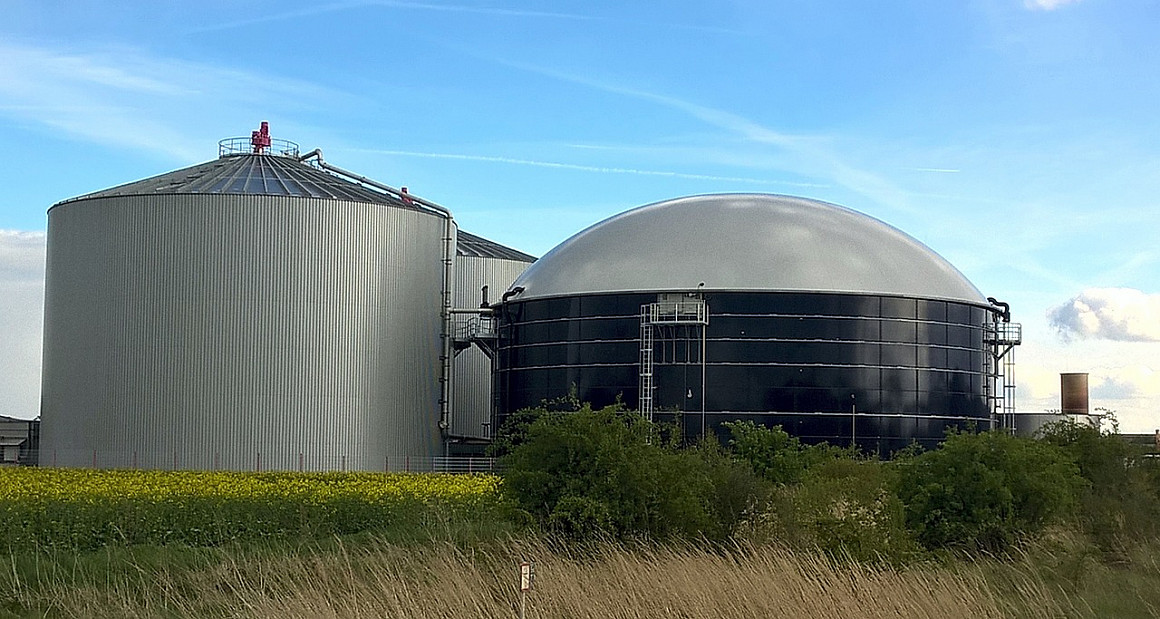main content Manure Biogas is All Hat and No Cattle
Miranda Herreid, a JD student in the Farmed Animal Protection Project, breaks down why manure biogas is not the solution and will further entrench factory farming.

Oregon’s dairy industry has experienced serious consolidation in recent years. The number of dairy cows housed in intensive confinement skyrocketed by 60% from 2002-2022. These massive cow populations generate millions of tons of manure, giving rise to a crucial question: what is to be done with all this waste? Lately, the dairy and energy industries have portrayed manure biogas as the solution, an idea that has garnered support from Oregon’s legislature in the form of tax credits and other incentives.
At first blush, manure biogas may look like a good idea. Its proponents present a win-win: by installing anaerobic digesters at dairy farms, we can dispose of noxious cow manure, decrease methane emissions, and sell the resulting product as energy. If all this sounds too good to be true, that’s because it is. In reality, the production of manure biogas flushes money down the drain, traps us in environmentally destructive industries, and perpetuates the suffering of the billions of animals confined in factory farms.
What Are Anaerobic Digesters?
Anaerobic digesters break down cow manure using bacteria in an oxygen-free setting. This results in a concentrated waste product: digestate (the material that is left after anaerobic digestion), and manure biogas, the latter of which can hypothetically provide heat and energy at the farm or be sold as an energy source to power vehicles and warm homes. Yet, beneath its eco-friendly veneer, manure biogas has fundamental flaws.
Anaerobic Digesters are not the Solution to the Environmental Harm Being Caused by Industrial Animal Agriculture
At its core, manure biogas perpetuates every problem it purports to solve. Firstly, in operation, manure biogas increases environmental harm. Although the production of manure biogas may decrease methane emissions from manure, it does nothing to address the root cause of most methane emissions: enteric fermentation, which is responsible for nearly three times the amount of methane emissions when compared to manure management.
Enteric fermentation is part of cows’ digestive process, and methane is released when cows burp and pass gas. Perversely, the production of manure biogas foments more methane emissions. Profiting off of manure biogas incentivizes larger herd sizes, leading to more methane entering the atmosphere via enteric fermentation and facilitating the growth of factory farms. This trend is not hypothetical: data shows that herds at facilities with anaerobic digesters grew by a rate of 3.7% annually, meaning more methane emissions and more animal agony. If one really wanted to address methane emissions, decreasing herd sizes would be the optimal solution. As an additional benefit, decreasing herd sizes would lessen the suffering experienced by the cows living in intensive confinement at these facilities.
Furthermore, contrary to how it is presented by the industry, the production of manure biogas is not a closed-loop system, in which a waste product is turned into something valuable. Instead, along with the manure biogas, anaerobic digestion results in an ultra-concentrated waste product, digestate, which is more difficult to dispose of than manure is, and leads to increased water pollution due to its nitrate density.
Secondly, building and operating an anaerobic digester is expensive and impractical for all but the largest farms. Construction of a digester can cost millions of dollars, and installation is only the first step of the process. Anaerobic digesters also incur regulatory costs, expenses associated with interconnection with the local power grid, and maintenance fees. Simply put, only the largest players can afford an anaerobic digester. An option for a farm that cannot afford a digester on its own is to partner with fossil fuel companies. While there is a lot of money being thrown at manure biogas production, this investment has not paid off: 22% of operational digesters have shut down. Worse, reports indicate that millions of taxpayer dollars have gone into funding these projects, with credits that were intended to promote green energy lining the pockets of polluters.
Third, although heralded as the energy of the future, investment into manure biogas traps us in the past. Fossil fuel companies and factory farms want consumers to believe that manure biogas is part of the solution to the energy crisis. However, industry efforts to promote manure biogas simply entrench existing fossil fuel dependencies, preventing a timely shift towards renewable energy sources such as electric, wind, and solar. The pipelines that would transport manure biogas also transport fossil fuels. Instead of embracing a need for real change, companies want to profit off of fossil fuel infrastructure, such as pipelines, for as long as they can, all while greenwashing their image, as alleged in a class action lawsuit.
Oregon has an ambitious emissions reduction goal of 80% from 1990 levels by 2050. It is unclear how this goal is attainable without holding fossil fuel companies and mega-dairies accountable for their environmental impacts. There is dissonance between Oregon’s ambitious climate goals on the one hand, and its involvement in the production and funding of manure biogas on the other. It’s time to craft real solutions for the climate crisis and force Big Ag and the gas industry to finally pay for their environmental harm. In Oregon, we can support legislation such as prohibitions on waste to energy projects and moratoriums on concentrated animal feeding operations in our state, like SB 80. Our collective future–for humans and non-human animals alike–depends on it.

The Center for Animal Law Studies (CALS) was founded in 2008 with a mission to educate the next generation of animal law advocates and advance animal protection through the law. With vision and bold risk-taking, CALS has since developed into a world-renowned animal law epicenter. CALS’ Alumni-in-Action from 30 countries are making a difference for animals around the world. CALS is a self-funded Center within the law school operating under the Lewis & Clark College 501(c)(3) tax-exempt status, and is able to provide these educational opportunities through donations and gra
Center for Animal Law Studies is located in Wood Hall on the Law Campus.
MSC: 51
email cals@lclark.edu
voice 503-768-6960
Center for Animal Law Studies
Lewis & Clark Law School
10101 S. Terwilliger Boulevard MSC 51
Portland OR 97219
More Stories

Despite International Protections, Threats to Rays Persist
Exploitation has driven ray species to the brink; emerging action in international law suggests that stronger protections for rays may be necessary.

The Law & Ethics of Using Animals in Research and Testing
Learn about our Law & Ethics of Animal Testing course and scholarship opportunities for those passionate about advocating for animals used in research and testing.

Companion Animal Law Evolves to Protect People and Their Pets
Lewis & Clark sparks a national movement to protect both people and their pets by redefining the role of companion animals in the legal system.

Protecting Farmed Animals in Memory of Thomas Bloom Raskin
Megan Rosen, LLM Candidate, Named Inaugural Recipient of the Thomas Bloom Raskin Animal Protection Scholarship
